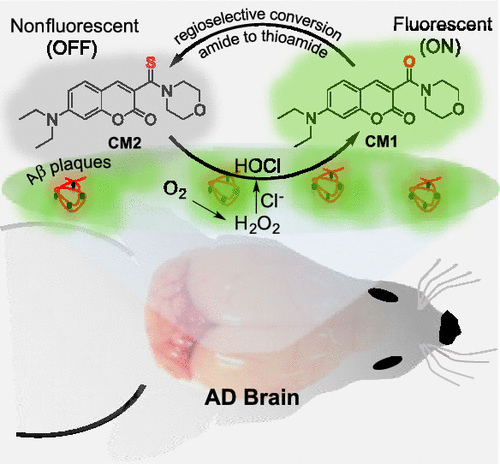当前位置:
X-MOL 学术
›
ACS Chem. Neurosci.
›
论文详情
Our official English website, www.x-mol.net, welcomes your
feedback! (Note: you will need to create a separate account there.)
Unambiguous Detection of Elevated Levels of Hypochlorous Acid in Double Transgenic AD Mouse Brain.
ACS Chemical Neuroscience ( IF 4.1 ) Pub Date : 2019-12-10 , DOI: 10.1021/acschemneuro.9b00554 Sourav Samanta 1 , Thimmaiah Govindaraju 1
ACS Chemical Neuroscience ( IF 4.1 ) Pub Date : 2019-12-10 , DOI: 10.1021/acschemneuro.9b00554 Sourav Samanta 1 , Thimmaiah Govindaraju 1
Affiliation

|
Alzheimer's disease (AD) is one of the most prevalent forms of dementia. The current diagnosis methods based on the behavior and cognitive decline or imaging of core biomarkers, namely, amyloid-β (Aβ) plaques and neurofibrillary tangles (NFTs), in the brain offer poor to moderate success. Detection and imaging of biomarkers that cause additional traits of pathophysiological aberrations in the brain are invaluable to monitor early disease onset and progression of AD pathology. The pathological hallmark of AD is associated with generation of excessive reactive oxygen species (ROS) in the brain, which aggravate oxidative stress and inflammation. ROS production involves elevated levels of hypochlorous acid (HOCl) and can serve as one of the potential biomarkers for the diagnosis of AD. We report the design, synthesis, and characterization of switchable coumarin-morpholine (CM) conjugates as off-on fluorescence probes for the specific detection of HOCl produced and proximally localized with amyloid plaques. The nonfluorescent thioamide probe CM2 undergoes regioselective transformation to fluorescent amide probe CM1 in the presence of HOCl (∼90-fold fluorescence enhancement and 0.32 quantum yield) with high selectivity and sensitivity (detection limit: 0.17 μM). The excellent cellular uptake and blood-brain barrier (BBB) crossing ability of CM2 allowed unambiguous and differential detection, imaging, and quantification of HOCl in cellular milieu and in the wild type (WT) and AD mouse brains. This study demonstrates the elevated level of HOCl in the AD mouse brain and the potential to expand the repertoire of biomarkers for the diagnosis of AD.
中文翻译:

明确检测双转基因AD小鼠大脑中次氯酸水平的升高。
阿尔茨海默氏病(AD)是痴呆症最普遍的形式之一。目前基于行为和认知能力下降或脑部核心生物标志物成像的诊断方法在大脑中的成功率很低,只有淀粉样蛋白β(Aβ)斑块和神经原纤维缠结(NFT)。导致大脑病理生理异常的其他特征的生物标记物的检测和成像对于监测AD病理的早期疾病发作和进展具有无价的作用。AD的病理特征与大脑中过量的活性氧(ROS)的产生有关,其加剧了氧化应激和炎症。ROS的产生涉及高水平的次氯酸(HOCl),并且可以作为诊断AD的潜在生物标记之一。我们报告设计,综合,的香豆素-吗啉(CM)偶联物的特性和表征,作为关闭的荧光探针,用于特异性检测产生的淀粉样蛋白斑块并向近端定位的HOCl。在HOCl存在下,非荧光硫酰胺探针CM2进行区域选择性转化为荧光酰胺探针CM1(荧光增强量约为90倍,量子产率为0.32),具有很高的选择性和灵敏度(检测限:0.17μM)。CM2具有出色的细胞摄取能力和血脑屏障(BBB)穿越能力,可以在细胞环境以及野生型(WT)和AD小鼠大脑中对HOCl进行明确和差异的检测,成像和定量。这项研究表明,AD小鼠大脑中HOCl的水平升高,并且有可能扩大生物标志物库,以诊断AD。
更新日期:2019-12-11
中文翻译:

明确检测双转基因AD小鼠大脑中次氯酸水平的升高。
阿尔茨海默氏病(AD)是痴呆症最普遍的形式之一。目前基于行为和认知能力下降或脑部核心生物标志物成像的诊断方法在大脑中的成功率很低,只有淀粉样蛋白β(Aβ)斑块和神经原纤维缠结(NFT)。导致大脑病理生理异常的其他特征的生物标记物的检测和成像对于监测AD病理的早期疾病发作和进展具有无价的作用。AD的病理特征与大脑中过量的活性氧(ROS)的产生有关,其加剧了氧化应激和炎症。ROS的产生涉及高水平的次氯酸(HOCl),并且可以作为诊断AD的潜在生物标记之一。我们报告设计,综合,的香豆素-吗啉(CM)偶联物的特性和表征,作为关闭的荧光探针,用于特异性检测产生的淀粉样蛋白斑块并向近端定位的HOCl。在HOCl存在下,非荧光硫酰胺探针CM2进行区域选择性转化为荧光酰胺探针CM1(荧光增强量约为90倍,量子产率为0.32),具有很高的选择性和灵敏度(检测限:0.17μM)。CM2具有出色的细胞摄取能力和血脑屏障(BBB)穿越能力,可以在细胞环境以及野生型(WT)和AD小鼠大脑中对HOCl进行明确和差异的检测,成像和定量。这项研究表明,AD小鼠大脑中HOCl的水平升高,并且有可能扩大生物标志物库,以诊断AD。











































 京公网安备 11010802027423号
京公网安备 11010802027423号